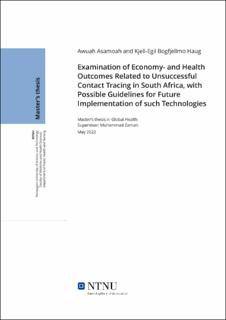| dc.description.abstract | Introduction: The COVID-19 pandemic has disrupted the world economy and health over the
past two years, with low- and middle-income countries experiencing the highest toll. South Africa is no exception, spending much money on fiscal support during lockdowns, postpones in treatment of other diseases, lower vaccination rates and increasing debt. The need of successful and effective use of non-pharmaceutical interventions (NPIs) is crucial, with special regards on digital contact tracing technology.
Methods: Time-series analysis of publicly available national data from South Africa, with special regards on defining pandemic patterns in the country. Using time-series analysis, it is possible to describe certain variables, explain the relationship between them and control for how one variable affects another. Our main variables under study are new cases, new deaths, hospital admissions and reproduction rates. Further, the thesis will develop a model for better pandemic surveillance in South Africa, while at the same time tracking effectiveness of digital contact tracing.
Results: The COVID-19 pandemic clearly follows seasonal patterns in South Africa. There are strong relationships between the variables under study, and the reproduction rate controls new cases and new deaths over time. Implementing a proper model surveillance, it is possible for the government to be alert when the pandemic drift out of control. In such case, contact tracing and other NPIs can be effectively implemented in the country, hindering lockdowns and new waves of COVID-19 in South Africa. With more control it is possible to focus on treatment of other diseases, due to more resources and availability in hospitals.
Discussion: Including both negative and positive scenarios of effective contact tracing surveillance, South Africa can implement effectively contact tracing technology to lower the total burden on the national healthcare system. The COVID-19 pandemic experience seasonal spikes forcing the country into lockdowns, and with proper surveillance one can hinder the largest outbreaks. However, it may be difficult to solely analyze contact tracing on its own due to the influence of other NPIs and natural behavior towards increase in cases.
Conclusion: Being alert when the COVID-19 pandemic drifts out of control with Cusum statistics, South Africa can implement necessary measures as effective contact tracing early during outbreaks, possibly ensuring stabilization in treatments of other diseases in the health care system, and at the same time allocating resources to other important health arenas. | |
